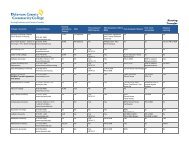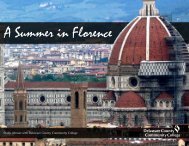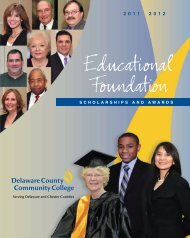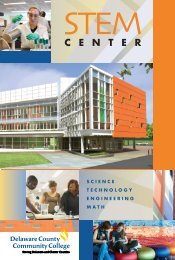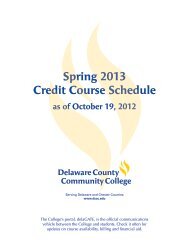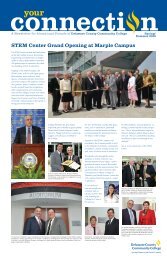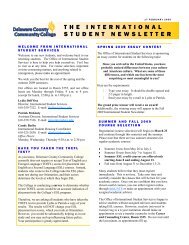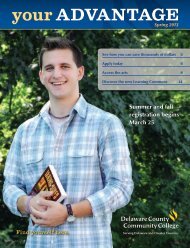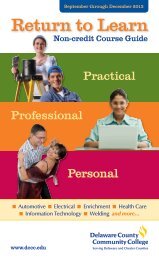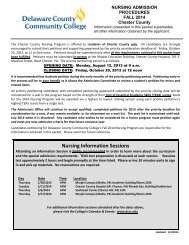2010 Catalog - Delaware County Community College
2010 Catalog - Delaware County Community College
2010 Catalog - Delaware County Community College
You also want an ePaper? Increase the reach of your titles
YUMPU automatically turns print PDFs into web optimized ePapers that Google loves.
148 COURSE DESCRIPTIONS<br />
• Discuss the nature of mechanical waves and apply this<br />
knowledge to problems involving sound phenomena.<br />
• Generate an explanation of light phenomena using<br />
geometrical, reflection, and refraction.<br />
• Discuss the nature of electrostatic forces and electricity<br />
concepts such as current, voltage, and resistance.<br />
• Describe magnetic forces and fields and design a<br />
simple motor.<br />
• Apply laboratory skills and computer technology to<br />
solve problems in a cooperative environment.<br />
Prereq. MAT 060 and REA 050<br />
4 Credits 3 Weekly Lecture Hours<br />
2 Weekly Laboratory Hours<br />
PHY 110<br />
<strong>College</strong> Physics I<br />
This is a course designed for science majors who are<br />
not in the calculus sequence. The course deals primarily<br />
with Mechanics and Thermodynamics.<br />
Upon successful completion of this course, students<br />
should be able to:<br />
• Describe motion in one dimension<br />
• Apply vector mathematics to explain<br />
two-dimensional motion<br />
• Describe and analyze freely-falling objects<br />
• Analyze motion using Newton's Laws<br />
• Apply conservation laws<br />
• Describe rotational motion<br />
• Analyze oscillatory motion<br />
• Describe and apply the basic concepts of<br />
thermodynamics<br />
• Apply laboratory skills and computer-based<br />
technologies to solve problems in a cooperative<br />
environment<br />
Prereq. MAT 140<br />
4 Credits 3 Weekly Lecture Hours<br />
2 Weekly Laboratory Hours<br />
PHY 111<br />
<strong>College</strong> Physics II<br />
This course is a continuation of <strong>College</strong> Physics I and is<br />
designed for Science majors who are not in the University<br />
Physics sequence. The course deals primarily with<br />
Electricity and Magnetism, Waves and Optics, and Modern<br />
Physics topics.<br />
Upon successful completion of this course, the student<br />
should be able to:<br />
• Describe electrostatic interactions in terms of force,<br />
fields, energy and potential.<br />
• Analyze circuits using Ohm's Law and Kirchhoff's Rules.<br />
• Describe the magnetic fields of simple geometries and<br />
their interactions with charged objects.<br />
• Define waves and their interactions.<br />
• Apply wave concepts to explain sound phenomena.<br />
• Apply the concepts of geometric and wave optics to<br />
the phenomena of refraction, reflection, interference<br />
nd diffraction.<br />
• Discuss the development of the atomic model and<br />
quantum mechanics<br />
• Use concepts of nuclear physics to describe<br />
decay processes<br />
• Apply laboratory skills and computer technology to<br />
solve problems in a cooperative environment<br />
Prereq. PHY 110, Coreq. MAT 141<br />
4 Credits 3 Weekly Lecture Hours<br />
2 Weekly Laboratory Hours<br />
PHY 131<br />
University Physics I<br />
This course is designed for Natural Science and<br />
Engineering majors who are required to take a calculusbased<br />
physics course. Dealing primarily with mechanics,<br />
the course covers the linear and rotational kinematics<br />
and dynamics of, and the principles, laws and concepts<br />
pertaining to, the motion of solids, along with specific<br />
applications relating to liquids and gases.<br />
Upon successful completion of this course, students<br />
should be able to:<br />
• Apply the kinematics equations to determine the linear<br />
motion of a particle.<br />
• Use the kinematics equations to determine the<br />
rotational motion of a solid.<br />
• Apply Newton's Laws of motion and gravity to the<br />
linear motion of a particle.<br />
• Apply Newton's Laws of motion to the rotational<br />
motion of a solid.<br />
• Know and apply the concepts of work and energy to<br />
solids, liquids and gases.<br />
• Utilize the concepts of momentum and conservation of<br />
momentum principle to analyze the interactions of<br />
particles and solids.<br />
• Use the concepts relating to the material properties of<br />
solids, liquids and gases.<br />
• Apply the concepts of periodic motion to solids<br />
experiencing simple harmonic motion.<br />
• Develop and use the kinematics and dynamics<br />
equations for wave motion as exhibited by liquids<br />
and gases.<br />
• Apply laboratory skills and computer technology to<br />
solve problems in a cooperative environment.<br />
Prereq. MAT 160<br />
4 Credits 3 Weekly Lecture Hours<br />
2 Weekly Laboratory Hours<br />
PHY 132<br />
University Physics II<br />
This course is a continuation of University Physics I<br />
and is designed for Natural Science and Engineering<br />
majors who are required to take a calculus-based physics<br />
course sequence. Dealing primarily with electricity and<br />
magnetism, the course covers the principles, laws and<br />
concepts of electrostatics and electrodynamics, including<br />
electromagnetic waves and physical and geometrical optics.<br />
Upon successful completion of this course, students<br />
should be able to:<br />
• Determine the electric field by the application of<br />
Coulomb's Law and Gauss's Law.<br />
• Apply the concepts of potential difference, capacitance<br />
and resistance to direct and alternating current circuits.<br />
• Utilize Kirchhoff's Rules to analyze direct and<br />
alternating current circuits.<br />
• Calculate magnetic fields by the application of the Biot-<br />
Savart Law and Ampere's Law.<br />
• Apply Faraday's Law of Induction to explain the effects<br />
resulting from changing magnetic fields.<br />
• Use Maxwell's Equations to explain the creation and<br />
properties of an electromagnetic wave.<br />
• Apply the concepts of geometric and wave optics to<br />
the phenomena of refraction, reflection, interference<br />
and diffraction.<br />
• Apply laboratory skills and computer technology to<br />
solve problems in a cooperative environment.<br />
Prereq PHY 131 Coreq MAT 161<br />
4 Credits 3 Weekly Lecture Hours<br />
2 Weekly Laboratory Hours<br />
PLB 100<br />
(PLB) Plumbing<br />
Plumbing Theory I<br />
This course is designed to provide the student with<br />
instruction in plumbing practices applicable to all areas<br />
of plumbing. Emphasis will be placed on presenting the<br />
history of plumbing, materials, tools and ideas in the<br />
plumbing industry. Traditional approaches are covered<br />
to ensure that the student receives a broad exposure to<br />
all materials and practices potentially encountered in<br />
the workplace.<br />
Upon successful completion of this course, students<br />
should be able to:<br />
• Explain the history of plumbing<br />
• Explain the development of plumbing codes<br />
• Define terminology associated with the trade, for<br />
example; ‘fitting allowance’<br />
• Specify fittings correctly<br />
• Identify various patterns of fittings<br />
• Define different types of sketches<br />
• Demonstrate the proper use of measuring tools<br />
• Calculate dimensions and interpret piping symbols<br />
• Perform basic measurements (expressed in feet, inches,<br />
and fractions)<br />
• Accurately measure pipes, threads, runs and angles<br />
related to plumbing installations<br />
• Calculate pipe sizes for drainage and service lines<br />
• Identify tools used to install plumbing systems<br />
• Explain the various methods of assembling pipe<br />
• Must be employed by a Master plumber<br />
5 Credits 3 Weekly Lecture Hours<br />
PLB 101<br />
Plumbing Theory II<br />
This continuation course is designed to stress good solid<br />
plumbing practices applicable to all areas of plumbing.<br />
Emphasis will be placed on presenting advanced concepts<br />
and materials in the plumbing industry. Traditional<br />
approaches are covered to ensure that the student receives<br />
a broad exposure to all materials and practices that may be<br />
encountered in the work place.<br />
Upon successful completion of this course, students<br />
should be able to:<br />
• Test and repair gas piping.<br />
• Describe the relationship of threads per inch to pipe size.<br />
• Identify the various tools for threaded pipe.<br />
• Describe the use of the tools for threaded pipe.<br />
• Explain how pipe is cut, reamed, and threaded.<br />
• Define the terms associated with pipe threading.<br />
• Demonstrate the procedures necessary to properly<br />
tighten fittings on pipes.<br />
• Tighten fittings on pipes and valves.<br />
• Define fitting allowance.<br />
• Interpret center-to-center measurements.<br />
• Perform fittings to obtain end-to-end measurements.<br />
Prerequisite: Must be employed by a Master plumber and<br />
PLB 100<br />
5 Credits<br />
PLB 102<br />
Math for Plumbers<br />
This course is designed to provide the student with<br />
relevant theory and skills in solving practical, industrially<br />
based, trade-related mathematical problems. Topics of<br />
instruction will include, but will not be limited to,<br />
calculating arithmetic expressions involving whole<br />
numbers, fractions, decimals, ratio, proportion, and<br />
percentages. The appropriate use of English/metric<br />
conversions, exponents, square roots, basic graph interpretation,<br />
and basic algebraic expression (formulas)<br />
manipulation will be presented. Emphasis is placed on<br />
providing the student with a problem-solving methodology<br />
applicable to new and future mathematical concepts.<br />
An introduction to the use of trigonometry for the solution<br />
of right and oblique triangles will also be included.<br />
Upon successful completion of this course, students<br />
should be able to:<br />
• Perform the addition, subtraction, multiplication and<br />
division of fractions.<br />
• Utilize ratio and proportion.<br />
• Define the Pythagorean theorem and show its use in<br />
plumbing for finding angles and offsets.<br />
• Solve square roots and perimeter, area, and<br />
volume problems.<br />
• Use mathematical concepts as they relate to<br />
plumbing projects.<br />
• Define the types of measurements used in<br />
plumbing projects.<br />
• Identify the mathematical symbols.<br />
• Define the use of symbols in mathematics<br />
• Define math procedure and math precedence.<br />
DELAWARE COUNTY COMMUNITY COLLEGE




